Archive for the ‘Gippsland (AU)’ Category
Friday, August 19th, 2011
(The following article was initially posted on CanDoBetter.net by Tigerquoll on 20090426. It has since been modified.)
.
 VicForests’ neo-colonial practice of logging old growth East Gippsland forests, justifies such culling by claiming compliance with Australia’s wood production Standard AS 4708-2007. But this standard is Mein Kampf for ecological genocide of East Gippsland Forests. VicForests’ neo-colonial practice of logging old growth East Gippsland forests, justifies such culling by claiming compliance with Australia’s wood production Standard AS 4708-2007. But this standard is Mein Kampf for ecological genocide of East Gippsland Forests.
Have a read: http://www.forestrystandard.org.au/files/Standards/4708.pdf [Read the Standard]
Under this official Australian Standard that sees only the wood for the trees, it includes two criteria that serve to deliver propaganda spin respect for forest ecology. One must recognise these criteria accompanying Criterion 4—Forest management shall maintain the productive capacity of forests. Need I say more?
Forestry Propaganda Criterion #3 for instance, requires forest management to ‘protect and maintain the biological diversity of forests’. Wonderful wholesome, noble and holistic rumblings about this one – but gullibles wake! VicForests <em>Mein Kampf</em> hides the ‘ chainsaw-speak‘ in the detail:
* ‘Small-scale clearing is permitted up to a limit of 40 hectares on a single forest management unit’. ‘Conservation of threatened (including vulnerable, rare or endangered) species and ecological communities requires the forest manager to minimise adverse impacts by ensuring he/she takes into account of known information and relevant specialist advice‘. (Makes Fiji look like a democracy!)
Forestry Propaganda Criterion 5 requires forest management to maintain forest ecosystem health and vitality, yet is so vague as to allow forest ‘practices’ only to ensure that damage stays “within tolerable levels”. Does this mean one tree per hectare can be left standing or may be two?
.
Then there’s Clause 4.5.3:
‘Forest managers managing native forests shall use fire and other disturbance regimes to maintain and enhance forest ecosystem health where appropriate to the forest type or scale.’ [p.25]
.
…that is, burn and disturb native forests at will, because we argue that doing so enhances forest ecosystem health. Whoops! The wind picked up and the forest is gone; still we complied with AS 4708-2007!
Such contemptible logic would argue that a bushfire raging through a town can to it good, because eventually the town is rebuilt and the people eventually return, look at Narbethong!
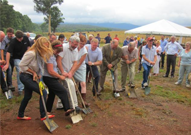
.
.
The Ferguson Tree – lest we forget
.
“The tallest tree ever properly measured was a Eucalyptus tree and was 436 feet tall. It was measured by William Ferguson on the 21st of February in 1872. Alarmingly the crown was broken off when the tree was still 1 meter thick, leading to claims that it once was up to five-hundred feet tall in one point in its lifetime.”
The length was a staggering (if true) 133 metres (436 feet) with its crown (the tree’s top) broken off!! The stump’s diameter five feet off the ground was 5.5m (18 feet) and at its broken top its diameter was still 1 metre. It is estimated that had this tree actually still been intact it would have approached 152m (500 feet) in height. The surveyor also noted numerous fallen trees in the same area over 106m (350feet) in height.
It would have been a Mountain Ash or Eucalyptus regnans. Sorry, no photo available. The legend remains only in text.
[Source: ^http://jtpredwoods12345.blogspot.com/]
.
.
‘VicForests accused of felling old-growth mountain ash’
.
[Source: Adam Morton, 20100629, The Age newspaper, ^http://www.theage.com.au/victoria/vicforests-accused-of-felling-oldgrowth-mountain-ash-20100628-zf5o.html]
.
‘The Victorian government’s forestry arm will face a legal challenge over claims it illegally logged old-growth forest and increased the risk to a threatened species.
Environmental groups accuse VicForests of felling dozens of pre-1900 ash eucalypts, breaching the Central Highlands Forest Management Plan. An impending legal case will also claim the timber agency failed to protect habitats necessary for the survival of Victoria’s threatened faunal emblem, Leadbeater’s possum.
Ecologist Jacques Cop, from consultants Acacia Environmental Group, said a survey of just one coupe near Toolangi found 31 pre-1900 ash eucalypts had been logged. Five stumps were more three metres across.
”These are trees that are 200 or 300 years old,” he said.
Mr Cop said the area should also have been protected as a Leadbeater’s possum habitat as it met the threshold of having at least 12 hollowed trees within three hectares. He said neither the state Department of Sustainability and Environment nor VicForests carried out ground surveys to check if ecological requirements were being met. Sarah Rees, president of local group My Environment, said the situation was an emergency.
’31 pre-1900 ash eucalypts had been logged’
.
“If this doesn’t stop we’re going to lose the last viable habitat for a range of different species, but Leadbeater’s possum carries the strongest case for legal protection“, she said.
The state government said it took the allegations “extremely seriously“.
Spokesman Michael Sinclair said VicForests would investigate the alleged breaches and report to the Department of Sustainability and Environment. VicForests spokesman David Walsh said the agency carried out detail planning before harvesting to ensure it acted within the law and had offered to meet local residents to better understand their concerns.
“No old-growth forest is harvested by VicForests in Victoria’s central highlands region”, he said.
The legal case, being prepared on behalf of a group called the Flora and Fauna Research Collective, comes amid community concern about the scale of logging in the central highlands after the Black Saturday bushfires.
The Wilderness Society said that evidence supporting the latest claims showed illegal logging of native forests was rife under the state government’s watch.
A separate allegation of illegal logging at Brown Mountain, in east Gippsland, is the subject of a pending Supreme Court judgment.
“Premier Brumby must act now to end VicForests’ woodchip rampage in Victoria’s magnificent native forests“, said Wilderness Society spokesman Luke Chamberlain.

Sarah Rees at the base of an ancient mountain ash spared the chainsaw but killed during a clean-up fire near Toolangi.
She says the present situation is an emergency.
Photo: John Woudstra
.
.
 VicForests motto reads: “Victorian Timber: beautiful, natural, functional” VicForests motto reads: “Victorian Timber: beautiful, natural, functional”
[SOURCE: http://www.vicforests.com.au/]
.
..in lay terms, this means kill beautiful natural specimens – they make the finest woodchips for reliable REFLEX office paper.
.
.
VICFORESTS: “VicForests employs over 140 staff across 10 Victorian sites located in Melbourne, Healesville and regional areas of Central Highlands and East Gippsland.
We have a variety of exciting career opportunities available – our Foresters specialise in tactical and operational planning, roading, harvesting and contract management, silviculture and native forest regeneration.
Other career paths include customer management, resource and business analysts, safety and risk, operational audit, forest scientists and product delivery.”
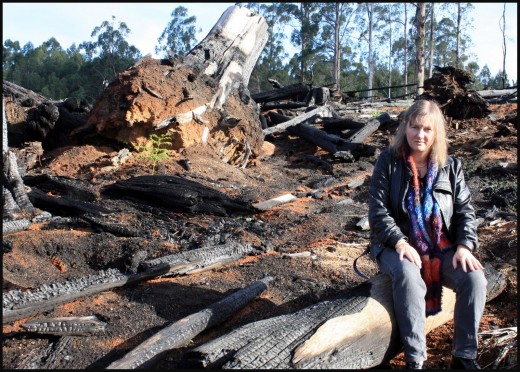
VICFORESTS: “We also employ staff in non-forestry roles including IT, HR, communications, finance, administration and customer service. A significant proportion of our staff and contractors are also involved with fire-fighting efforts each year.
VicForests is focused on investing in its employees through training, development, and providing career opportunities.”
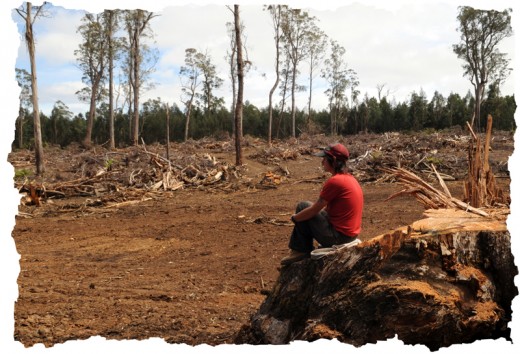
VICFORESTS: “We look for dynamic people who have a strong desire to be part of an organisation that strives to achieve success through implementing excellent and innovative business and timber industry practices for our customers and stakeholders.
Contributing to the timber industry is something that VicForests and its staff are proud of.”
.
[Source: ^http://vicforests.logic1.com.au/employment.htm, accessed 20110819]
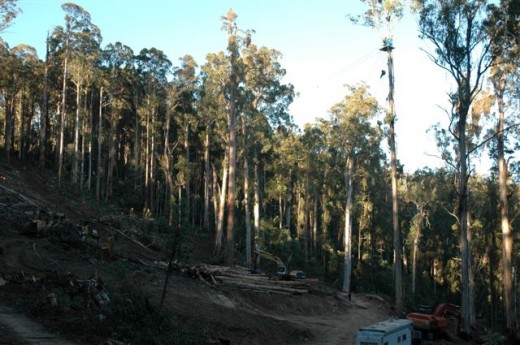 Vicforests’ coup at Stoney Creek
East Gippsland 2009 Vicforests’ coup at Stoney Creek
East Gippsland 2009
.
.
‘VicForests’ 2009 Annual Report reveals $5.1 million loss’
.
‘VicForests’ 2009 Annual Report has once again revealed that the logging agency continues to waste taxpayer millions of dollars sending our forests to the woodchip mills. The report shows that VicForests has posted a loss this year of $5.1 million. This is on top of last year posting a tiny profit after receiving a $5 million lifeline from government, and a loss the previous year.
 Woodchip train makes its way to Midways, Geelong (2009) for as little as $2.50 per tonne.
Photo: Wilderness Society Collection
Woodchip train makes its way to Midways, Geelong (2009) for as little as $2.50 per tonne.
Photo: Wilderness Society Collection
.
‘Whilst VicForests squanders Victorian taxpayer’s hard earned money, woodchipping and paper companies continue to post handsome profits. Whilst we don’t yet know how much they will make for 2009, South East Fibre Exports, a wholly owned subsidiary of Japanese paper giant, Nippon Paper, last year made over $10 million profit. They woodchipped approximately half a million tonnes of Victoria’s native forests, and this year paid as little as $2.50 per tonne for them.
Another giant company, Australian Paper, which makes Reflex papers, is VicForests’ largest single customer and was recently purchased for around $700 million by Nippon Paper. The $5.1 million loss is on top of an extra $1.3 million handout for bushfire recovery and does not include the massive $29 million royalty that it has failed to hand over to the state government who, along with the Victorian public, own these forests.’
.
[Source: ^http://www.wilderness.org.au/campaigns/forests/vicforests-2009-annual-report-reveals-5.1-million-loss]
 A tombstone of the once impenetrable forest.
A Mountain Ash stump alongside an old forestry track in Balnook, Gippsland.
Note the notches cut in the trunk for standing planks to cut the tree down by axe!
A tombstone of the once impenetrable forest.
A Mountain Ash stump alongside an old forestry track in Balnook, Gippsland.
Note the notches cut in the trunk for standing planks to cut the tree down by axe!
.
.
Reflex Office Paper
‘Paperlinx’s giant Maryvale mill located in Victoria’s Central Highlands is the largest pulp and paper making complex in Australia, consuming 475,000 cubic metres of eucalyptus forest per annum (RFA, 1998).
‘In July 2006, the Maryvale Mill received Forest Stewardship Council (FSC) Chain of Custody Certification for A4 Reflex products manufactured on its Number 3 and Number 5 Paper Machines. Paperlinx has been proudly promoting its environmental credentials ever since (as well as before).
Paperlinx is Australia’s only office paper producer. Its flagship product REFLEX copypaper is 100 per cent virgin native forest. Woodchips to make the paper are sourced from areas including rainforest, old growth forest, endangered species habitat and Melbourne’s largest water source, the Thompson Dam catchment area. Woodchips are also sourced from the Strzelecki Rainforest Reserve, an area that was promised protection by the state government due to its high conservation value.
These areas can be visited and viewed first hand, or determined by satelite image maps which show different forest types (such as rainforest as compared to woodlands) and where logging is occuring. The fact that Paperlinx gained FSC accreditation has raised concerns amoung environment groups who have been campaigning for the protection of these areas for over a decade.
Reflex Recycled Paper
Paperlinx has recently released a brand of paper wrapped in green packaging labelled Recycled. Fifty percent of REFLEX Recycled paper is made from pre-consumer waste (printers’ offcuts), but no genuine post-consumer (eg kerbside collected) recycled papers. The other fifty percent is from the same virgin native forest as stated above.
According to The Wilderness Society Paperlinx has the resources and technology to make use of alternative sources such as plantations and recycled paper, but doesn’t do so as it receives state-owned native forest logs for a significantly lower cost than plantation logs.
Due to the lack of accurate information reaching the public, an alliance of Australia’s peak environment groups including The Wilderness Society, Environment Victoria, Friends of the Earth and the Australian Conservation Foundation released a flier in 2004 urging people to boycott REFLEX paper and listing alternatives.
THE ALTERNATIVE
There is no 100 per cent recycled office paper manufactured in Australia. Brands made overseas that are available in Australia include Evolve, Canon 100 and Fuji Xerox Recycled Supreme.’
[Source: ‘Reflex Office Paper‘, Greenwash .org ^http://www.greenwashreport.org/node/41 ]
.
‘Always rely on Reflex to woodchip old growth‘
  Scott Gentle from the Victorian Forest Contractors Association
questions the logic of the Yarra Ranges council’s decision to boycott Reflex paper products.
[Source: ^http://free-press-leader.whereilive.com.au/news/story/paper-ban-anger/] Scott Gentle from the Victorian Forest Contractors Association
questions the logic of the Yarra Ranges council’s decision to boycott Reflex paper products.
[Source: ^http://free-press-leader.whereilive.com.au/news/story/paper-ban-anger/]
.
.
Further Reading:
.
[1] ‘Brown Mountain Rape’, ^http://candobetter.net/node/1005
[2] Ethical Paper, ^http://www.ethicalpaper.com.au/
[3] Save Sylvia Creek Toolangi, ^http://www.myenvironment.net.au/index.php/me/Community/SAVE-Sylvia-Creek-Toolangi
[4] Brown Mountain – final court orders, ^http://www.eastgippsland.net.au/?q=campaigns/brown_mountain/whats_new
[5] Reflex Office Paper, ^http://www.greenwashreport.org/node/41
[6] Victorian Supreme Court Decision: ‘Environment East Gippsland Inc v VicForests [2010] VSC 335 (11 August 2010)’, ^http://www.austlii.edu.au/au/cases/vic/VSC/2010/335.html
.
.
– end of article –
Tags: Acacia Environmental Group, Australian Paper, Brown Mountain, chainsaw-speak, East Gippsland logging, ecological genocide, Ferguson Tree, Forestry Standard 4708, Forestry Standard Certification, Gippsland Giants, illegal logging, Leadbeater’s possum, Logging, Nippon Paper Group, Reflex Paper, Toolangi, VicForests
Posted in Gippsland (AU), Possums and Gliders, Threats from Deforestation | No Comments »
Add this post to Del.icio.us - Digg
Thursday, August 18th, 2011
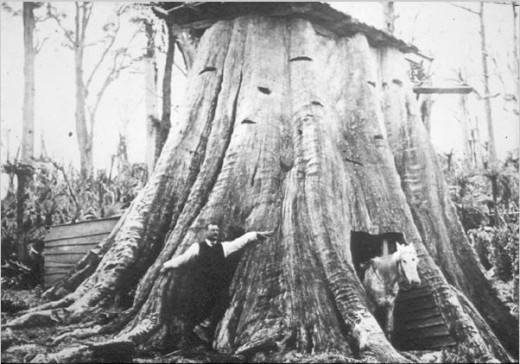
Gippsland Giants
by John Stephens
.
‘Do you know that possibly the biggest living thing in the world once lived in Gippsland and that its descendents still live here? No it’s not the blue whale, nor the giant kangaroo or the thylacine or even the black panther, it’s Eycalyptus regnans, the Victorian or Mountain Ash! These trees are the world’s tallest hardwoods and the tallest flowering plants.
The trees in the Tara Bulga Park are certainly imposing and of an impressive size, somewhere in the vicinity of sixty metres tall! You’ve seen Mountain Ash on drives or walks throughout the Strzelecki Ranges or the Baw Baw plateau. But I’m sorry to tell you, that you haven’t seen a real Mountain Ash and are most unlikely to ever see one. Of course I am talking about specimens that did exist before we “harvested” them. I don’t consider myself a “greenie” however I cannot be anything but amazed at the destructiveness of the human species.
During my “younger days” I spent many an enjoyable hour riding a motorcycle around the top end of Merriman and Traralgon Creeks. One of my greatest memories was seeing the stumps of some huge trees that had been logged, somewhere on the western side of the Merriman Creek headwaters, and imagining what they must have looked like in their original grandeur. I also came across the huge “historic” tree stumps at Mt Tassie and as many others have, I marvelled at their massive girth.
The Ada Tree near Powelltown, which is estimated to have existed for over three hundred years, is possibly the largest remaining specimen in Victoria. It has been preserved and is estimated to stand at about 76 metres, although it was significantly taller. The crown has been blown away either in a storm or struck by lightning, meaning the tree may have reached a height in the vicinity of 120 metres. Another giant, The Big Tree, in the Cumberland Tall Trees Reserve is 82 metres tall, but was 92 metres before a storm destroyed the top in 1959. What stuns me, is that if I imagine one of these trees to be the imposing Eucalyptus obliqua in the top corner of my block and it fell along the fence line, it would stretch the full 83 metres of the block!
“The Baron” height – 66m, girth 14.5m
 |
Near Narbethong – 91m, girth 7.7m
 |
I understand that to our pioneers the supply of forest, trees and timber seemed endless and they had a need to provide land for agriculture and development. However I do not understand their need to destroy everything that they saw as a challenge. Why did they have to destroy the Centennial Exhibition Tree that had stood in the Menzies Creek forest for hundreds of years until its demise in 1888? It was measured at over 122 metres after being felled and was reassembled for display at the exhibition in Melbourne. Surely it would have been better to take parties to visit the living tree in its natural surrounds and glory.
Part of an article written by Paul Edwards cleverly conveys what most of us feel about these giants – “When a tree gets old and tumbles, it becomes a noble thing — a fallen tree — but when it is cut down it turns into a log”. The best way to measure a tree is of course to do so when it has been cut down. This is essentially what happened to another giant at Thorpdale. It was felled in the1880s, measured by the surveyor G Cornthwaite, and found to have been 114.3 metres tall. I believe all that remains to signify the existence of this giant is a sign on the roadside indicating where it once stood, definitely far less impressive than the tree itself.
Some of these old trees must have been even more impressive. A 66 metre tall tree in Sassafras Gully in the Dandenongs and known as “The Baron” had a girth of 14.5 metres. The Bulga Stump, which was destroyed in the 1939 bushfires, famous for its huge girth of 34 metres! The Furmstons or Mueller Tree near Mt Monda was only 60 metres high when it fell in 1998 although it was estimated to be well over 100 metres when it was first discovered in the late nineteenth century. Another giant was a hollow stump in the Tarra Bulga area that had a roof and was used as a stable. The hollow Wonga Stump near Yarram was used as a church and a school until it was destroyed by fire in 1898.
The tallest known existing tree in the world is now a Californian Redwood (Sequoia semprivirens) found in the Humbolt Redwood State Park. It is 112.7 metres in height but is “small” compared to the tallest ever recorded, an American Douglas fir (Pseudotsuga menziesii) which was known to be 122 metres, equal to our Centennial Tree. However do these trees really compare to our own? A tree at Mt Baw Baw measured in 1889 by surveyor G W Robinson was reported to be 143 metres in height.
In 1872 the Victorian Government surveyor, William Ferguson, reported finding a fallen tree in the Healesville area that was 133 metres long. The top had been broken off in the fall and most of the crown burnt in a fire. Where it was broken the tree was approximately one metre in diameter and was estimated therefore to have been 152 metres tall!
Were there bigger specimens or are there still giants in the Gippsland forests? Maybe there was a tree of such dimensions that if in my imagination it fell the length of my block it would also complete the side boundary of the property behind mine.
[Source: ^ http://home.vicnet.net.au/~apslvg/gippslandGiants.html]
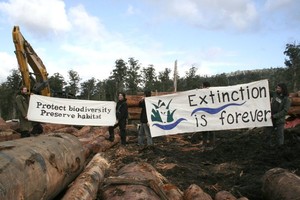
Title of this article is derived from two well known sayings:
- ‘Forgive them, for they know not what they do.’ Source: The Bible: ‘And Jesus said, “Father, forgive them, for they know not what they do.” And they cast lots to divide his garments.’
[© English Standard Version, Luke (23:34) 2001)]. These are supposedly Jesus’ words from the cross, asking forgiveness for those who put him to death. More widely, of course, the plea was for all humanity. [Rare historic photos of these magnificent trees are all that allow us to remember what once was. The saying is quite apt to old-growth trees, though I have removed the ‘Father, forgive them‘ clause.]
- ‘Lest we forget‘ Source: Rudyard Kipling’s poem of 1897, ‘Recessional’, which he composed on the occasion of Queen Victoria’s Diamond Jubilee in 1897. The poem, on the one hand, expresses pride in the British Empire, but, on the other, expresses an underlying sadness that the Empire might go the way of all previous empires. [Again, quite apt to old-growth trees.]
.
‘God of our fathers, known of old—
Lord of our far-flung battle line—
Beneath whose awful hand we hold
Dominion over palm and pine—
Lord God of Hosts, be with us yet,
Lest we forget—lest we forget!
The tumult and the shouting dies—
The Captains and the Kings depart—
Still stands Thine ancient sacrifice,
An humble and a contrite heart.
Lord God of Hosts, be with us yet,
Lest we forget—lest we forget!
Far-called our navies melt away—
On dune and headland sinks the fire—
Lo, all our pomp of yesterday
Is one with Nineveh and Tyre!
Judge of the Nations, spare us yet,
Lest we forget—lest we forget!
If, drunk with sight of power, we loose
Wild tongues that have not Thee in awe—
Such boastings as the Gentiles use,
Or lesser breeds without the Law—
Lord God of Hosts, be with us yet,
Lest we forget—lest we forget!
For heathen heart that puts her trust
In reeking tube and iron shard—
All valiant dust that builds on dust,
And guarding calls not Thee to guard.
For frantic boast and foolish word,
Thy Mercy on Thy People, Lord!
Amen.
.
– end of article –
Tags: Centennial Exhibition Tree, Dandenongs, Eucalyptus regnans, Gippsland, Gippsland Giants, Logging, Menzies Creek, Mountain Ash, Mt Baw Baw, Mueller Tree, old growth, The Baron, The Big Tree, The Bulga Stump, Thorpdale, world's largest trees
Posted in Gippsland (AU), Threats from Deforestation | No Comments »
Add this post to Del.icio.us - Digg
Wednesday, August 17th, 2011
The following article was initially posted by Tigerquoll on 20090423 on CanDoBetter.net:
.
I have to pinch myself to realise this is 2009 and not 1959!
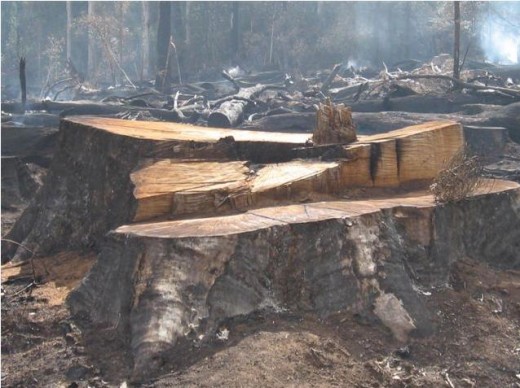 Vicforests’ logging arson to 600 year old Eucalyptus regnans in East Gippsland, Victoria, Australia, 20090423
http://www.lighterfootprints.org/2009/04/brown-mountain-destruction-complete.html Vicforests’ logging arson to 600 year old Eucalyptus regnans in East Gippsland, Victoria, Australia, 20090423
http://www.lighterfootprints.org/2009/04/brown-mountain-destruction-complete.html
This photo just in from the old growth forests of Brown Mountain in East Gippsland – home of remnant giant Australian natives dating up to 600 years old. This photo shows the Brown Mountain Massacre yesterday (23 April 2009) of these magnificent giants by VicForests on its celebrated World Forestry Day.
In 2006, the then Premier, Steve Bracks, made a promise to “protect all significant stands of old growth currently available for logging” (hollow words by a man of renouned indecision). The immense trees that have sheltered and raised hundreds of generations of owls and gliding possums are now being hacked down by VicForests.” [Source: Environment East Gippsland’s, ‘The Potoroo Review‘, Issue 196]
VicForests’ leadership inspiration, Warren Hodgson, must feel pround leaving such a legacy of heritage denial to future Gippslanders, Victorian and Australians. “Warren Hodgson has been involved in policy development at the highest level of the Victorian public sector and has previously led the Victorian Government efforts on Public Private Partnerships. He has a background in the manufacturing industry in New Zealand and in the provision of contract services to public and private sectors throughout the Asia-Pacific region.”
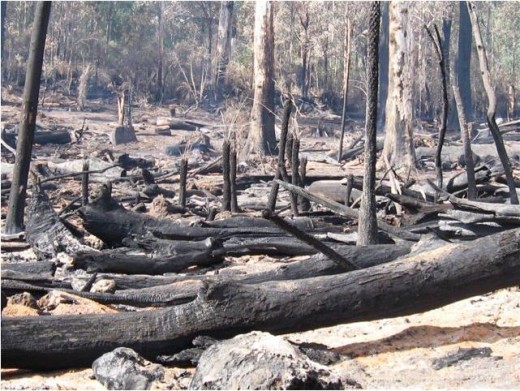
.
.
.
‘VicForests’ (from its website) presents its vision and values as:
.
Our vision:
“To be a leader in a sustainable Victorian timber industry.”
Our purpose:
“To build a responsible business that generates the best community value from the commercial management of Victoria’s State forests.”
Our values:
“Accountable – VicForests is accountable to the Victorian Government. Its actions and those of its employees must be consistent with relevant Government policy and priorities.”
Committed – “VicForests is committed to the fulfilment of its purpose and the achievement of its vision for the Victorian timber industry.”
Safe – “VicForests and its staff will manage safe workplaces for all staff and contractors, and are committed to continuous improvement in safety systems and outcomes, in accordance with its Occupational Health and Safety Policy.”
Customer focused – “VicForests will be responsive to its customers’ requirements and seek customer satisfaction, in accordance with its commercial nature.”
Ethical – “VicForests will operate in an ethical and environmentally responsible manner in all its undertakings to ensure the integrity and sustainability of the native forest timber industry in Victoria.”
Innovative – “VicForests seeks to be innovative and adaptable in its organisational, business and forestry management operations.”
Open – “VicForests will manage the commercial harvesting and sale of timber in a framework of openness and transparency.”
Professional – “VicForests and its staff will operate in a professional manner in all undertakings to ensure the best possible outcomes for the organisation, its customers, the Victorian timber industry and its stakeholders.”
Sustainable – “VicForests will pursue the highest standards for forest management practices through the continued development of its Sustainable Forest Management System and by ensuring its triple bottom line performance against the requirements of Victoria’s Sustainability Charter for State forests.”
[SOURCE: http://www.vicforests.com.au/vision-purpose-and-values.htm]
.
.
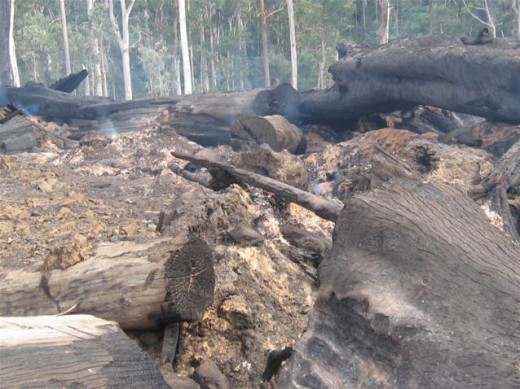
I have to pinch myself to realise this is 2009 and not 1959!
.
.
.
Brown Mountain – destruction complete!
.
An urgent message from Jill Redwood of Environment East Gippsland (from 20090424). . .
“These were taken yesterday – VicForests mission accomplished.
This ancient stand of 600(plus) year old forest has now been fully annihilated and ready for conversion to a palm-oil plantation. Or it might as well be.
They’ll actually be converted to a pulpwood plantation for the Japanese paper industry.
The other four remaining stands of old growth adjoining are on the logging schedule.
Please help in whatever way you can.”
~ Jill [Environment East Gippsland]
.
.
.
Read More:
.
[1] ^http://www.greenlivingpedia.org/Brown_Mountain_old_growth_forest
[2] ^http://www.eastgippsland.net.au/
[3] ^http://www.eastgippsland.net.au/?q=campaigns/brown_mountain
.
– end of article –
Friday, July 22nd, 2011
The following article was initially posted by Tigerquoll 20090408 on CanDoBetter.net:
.
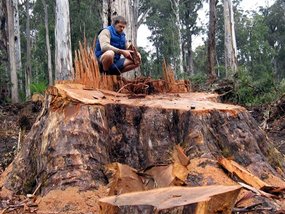 © Photo EEG 2009 © Photo EEG 2009
.
Radiocarbon-testing has confirmed that a giant rare old-growth Eucalyptus regnans located in its natural forest habitat on East Gippsland’s Brown Mountain has been chainsawed by VicForests, despite it being scientifically confirmed to be at least 500 years old.
No regard has been made for the existence value of a Victorian 500 year old natural asset, nor the habitat requirements for the typical arboreal animals and forest owls dependent on this old growth habitat tree or its associative forest dependent habitat. Under State-
sanction, ignorant VicForest butchers have plundered, ransacked and run.
 © Photo EEG 2009 © Photo EEG 2009
.
Manager, Victorian Department of Sustainability and Environment, Orbost, Steve DeVoogd, has been formally advised that this chainsawing of rare old growth forest is an offence committed under the section 46(1) of the Sustainable Forests (Timber) Act 2004. The action is also a breach of Code of Forest Practices (CFP). VicForests Chairman, Warren Hodgson, Board members Monica Gould, Jim Houghton, Fiona McNabb, Bob Smith, Susan Walpole, and Chief Executive Officer David Pollard should all be sacked forthwith. VicForests token ‘vision’ ‘purpose’ and ‘values’ which profess motherhood notions of ‘sustainable’, ‘environmentally responsible’ and ‘ethical’ are but ‘Mugabean’. This 500 year old tree epitomises the reality of Brumby’s ‘Sustainability Charter for State forests.
Botanist Steve Mueck has worked for the Victorian Department of Natural Resources and Environment and is now a consultant in the private sector. He says radiocarbon dating of eucalypts is unusual and the result in this case is significant.
“Current forest managements practices are looking at harvesting on rotation times in the vicinity of 80 to 120 years with the perception that that’s a particularly long period of time,” he said.
“Now it is, I suppose, in the context of a human lifetime, but it is a very, very short period of time in comparison to the age in which many of the components that live in these forests can in fact get to in a natural system.”
Back in the 1860s timber workers and naturalists emerged from the forests with stories of massive trees towering to immense heights and as wide as houses.
Government botanist Ferdinand von Mueller recounted the existence of a tree as high as the Egyptian Pyramids at 480 ft (144m) and another fallen tree in the Dandenong Ranges over 400 ft (120m). A giant was sighted in the Otways with a girth of 64 ft (19m).
VicForests senseless decapitation of one of the last Victorian giants is a harbinger of extinction to Victoria’s old growth forests.
It’s like grabbing an old ANZAC from a ‘march past’ and slitting his throat.
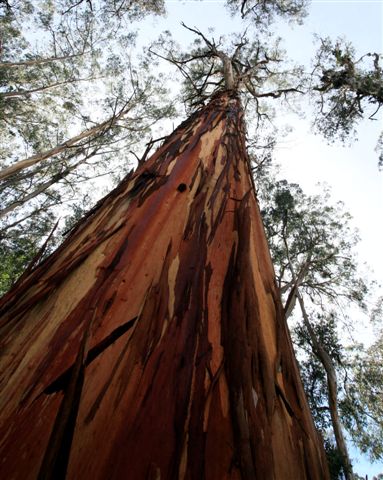 © Photo EEG 2009 © Photo EEG 2009
.
.
Comments:
.
‘Victorian Labor’s “sustainable” principles are thin and shallow’
by Vivienne 20090410:
.
In 2006 the Labor Party pledged to “protect remaining significant stands of old growth forest currently available for timber harvesting by including them in the National Parks and reserves system”.
This promise was blatantly broken.
The trees on of Brown Mountain have not burned for 200 years despite repeated fire threats. The resistance of these old forests to bushfire is evident. This area is also the home of several highly endangered native species.
Clear felling of old growth forests has continued despite their critical role in storing carbon and providing water for the depleted Snowy River catchment.
The Victorian government states that 90% of our forests are preserved. However, only 16% of Victoria is protected, and over 80 percent of what is logged in East Gippsland ends up as mere woodchips!
Clearing 10% of our forests is plainly too much considering that Victoria remains the most cleared and damaged State of Australia.
Our Brumby government is guilty of serious eco-destruction and policy violation, and any claims of “sustainable” principles are demonstrated to be thin and shallow.
.
– end of article –
Tags: biodiversity, Brown Mountain, Brumby's 'Sustainability Charter for State forests, Code of Forest Practices, deforestation, Department of Sparks and Embers, East Gippsland logging, John Brumby, save our forests, Sustainable Forests (Timber) Act 2004, VicForests, Victoria's old growth forests, Victorian Department of Sustainability and Environment, Victorian Labor
Posted in Gippsland (AU), Threats from Deforestation | No Comments »
Add this post to Del.icio.us - Digg
Wednesday, July 20th, 2011
The following article was initially posted by Tigerquoll on 20090326 on CanDoBetter.net:
.
On Thursday 26th March 2009, four people were charged in their efforts to save East Gippsland old growth forests at Upper Delegate River from being chopped down.
 ‘The Goongerah Blockade’ ‘The Goongerah Blockade’
Protesting against logging of old growth forests in East Gippsland
….prepared to be arrested for habitat.
March 2009.
eco-warriors all!
.
Conservationists trying to conserve protected old growth forests have been charged with illegal conservation. Is Victorian Premier Brumby’s strongman stance seeking to emulate Mugabean democracy?
Is Brumby’s hypocritical law for conservationists that of prima facie guilt of conservation? Surely the need to conserve rare and remnant old growth forests makes conservation self-evident?
Premier Brumby’s DSE and VicForests under their own laws maintain these catchment forests under environmental protection legislation. Yet in breach of their own laws, Brumby’s environmental watchdogs have become lapdogs, watching loggers irreparably destroy these centuries-old Eucalypts and lay witness to Victoria’s disappearing natural heritage. It’s no different to Indonesia condoning destruction of Sumatran and Kalimantan rainforests.
When was the last time Brumby bushwalked through old growth Gippsland? Last year, or never?
A dedicated group of 20 forest conservationists prevented clearfelling in the upper Delegate River catchment up until now. “This particular old growth forest was recently surveyed by trained biologists and the result showed very high density of tree dwelling mammals”, said spokesperson for the group Carmel Roberts.
“The DSE is neglecting their responsibilities to protect endangered wildlife habitat, even though it clearly states in their Forest Management Plan that where high numbers of threatened species are found, habitat must be protected.
“The DSE are saying they are unable to protect these species’ habitat despite the logging being in clear breach of their legal obligations. The government puts more value on a months work by a few people than protecting endangered wildlife from extinction.
“In 2006, Premier Brumby made an election promise to protect the “last significant stands of old growth”. These forests are the very the last refuges for our rare species.”
“Since the devastation caused by the bushfires, East Gippsland’s forests are now even more critical to the survival of Victoria’s native species than before. Rare native wildlife could have been made locally extinct in other areas due to the fire damage.”
“Old growth forest habitats such as hollow-bearing trees, are critically important for the survival of these threatened species in Victoria. The logging industry can survive in plantations and regrowth, endangered wildlife can’t.”
.
.
Comments:
.
Woodchip mafia has Brumby well trained
March 28th, 2009 by ‘Blackdog’:
.
The Brumby government is truly the lapdog to the loggers. The woodchip mafia has him well trained. The rule book says the threatened species have to be saved. He destroys them and their habitat. The promise back in 2006 was to save the old growth – but all he’s done is cover for the increased targeting of prime areas.
Yep – no different to Indonesia or the Amazon. Only Brumby employs better media spin experts. Pity the public don’t wear it.
.
.
Lap dog governments are following Easter Island
On March 28th, 2009 Tigerquoll says:
Blackdog’s comments hit the mark.
I go further than black dog.
Lap dog governments are supporting destructionist loggers while publicly advocating environmental protection in another department.
This is gross hypocracy, a conflict of interest and corrupt.
I worry also that as more clever HSC graduates take on degrees in ‘communications’, which so frequently entices them into well paid jobs in government and corporate spin machines, that pure ethics is neglected at both senior school and at most university courses.
By denying our children skills and wisdom in worldly ethics, our children are being denied their rights to cope with ethical decisions. A degree without a base in ethics is a degree in propaganda, and don’t our lapdog governments lap them up?
Take the following example and ask why in our education system and supposed independent journalism, that Australians are more aware of the extremely rich celebrities than the natural and indigenous exploitation and neglect condoned by governmenst in Australia’s World region?
SOURCE: www.drmartinwilliams.com/conservation-and-environment/indonesian-forest-destruction-corruption-plays-a-role.html
“Since 1982, forest fires on a large scale in Kalimantan, Sumatra and Java have come with the onset of each dry season. A fire in Kalimantan in 1983, reportedly the largest in human history, destroyed 3.7 million hectares of rainforest, an area the size of the Netherlands.
In 1987, 2 million hectares, 1.4 million of primary rainforest, were destroyed in Kalimantan, Sumatra, East Timor, Sulawesi and mountain regions of Java.
In 1991 smoke and ash from fires blanketed Singapore, Malaysia and the Straits of Malacca, forcing Indonesia to call for international help.
Forest fires of this magnitude coincide with a rapid increase in logging and plantation activities which began in the early 1980s. In 1966, 82% of Indonesia’s land mass was covered by primary forest. By 1982 this had shrunk to 68%, and recent satellite photographs indicate that forest cover – including timber plantations – is now down to about 55%.
In late 1996, the Indonesian minister of forests said that 20 million hectares of forest were in a critical state and warned that this was increasing rapidly. The World Bank estimates 800,000 hectares of forest are lost each year.
Around 64 million hectares – one-third of Indonesia’s land mass – is devoted to commercial logging. In 1996 Indonesia became the world’s largest plywood exporter.
…
On September 9, Suharto reissued a 1995 ban on burning forest and called on the military to help enforce it. Companies were given until October 3 to prove they were not the culprits.
Laws allow up to 10 years’ imprisonment and a 100 million rupiah fine for polluters. Not one company, however, has ever been convicted. Even the environment minister, Sarwono Kusumaatmadja, admitted to Reuters on September 22 that environmental laws are not policed properly.
Soon after Suharto’s announcement, the number of fires increased, as companies rushed to clear as much land as possible before the deadline. Even if the deadline was strictly adhered to, it would only let companies finish clearing land at a time the normal rainy season would have forced them to do so.
…
But it is not just the greed of Suharto and the logging and plantation firms which has created this disaster.
Government investment and development policies which have promoted destructive land clearing practices are spurred on by market forces and capitalism’s endless drive for profit. Many of the projects were championed by and funded by institutions such as the World Bank and the IMF, which pressure countries such as Indonesia to increase exports.”
In 2009, we must learn from Easter Island’s ancient community and its unsustainable culture of nature exploitation which ended up condemning its civilization to extinction. Else, despite our iPods, in 2009 we risk the same fate.
.
.
Injustice rules the forests
March 30th, 2009 by Sheila Newman:
.
About time this shameful situation got coverage. I would like to see a story for EVERY charge against conservationists on candobetter.
It is quite true, as you say, that the Victorian Government frequently breaks the law in its forest activities. In fact it has practically torn up its own rule book.
Keep fighting!
.
– end of article –
Tags: Carmel Roberts, clear felling, conservationists charged, East Gippsland, Goongerah Blockade, John Brumby, Logging, old growth forests, Premier Brumby, tigerquoll, Upper Delegate River, VicForests, woodchip
Posted in Gippsland (AU), Threats from Deforestation | No Comments »
Add this post to Del.icio.us - Digg
Tuesday, June 14th, 2011
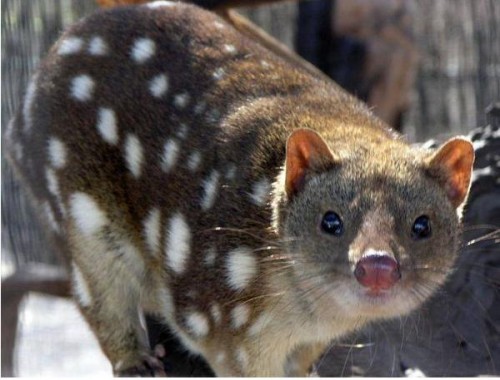 This is a Tiger Quoll (Dasyurus maculatus) This is a Tiger Quoll (Dasyurus maculatus)
Photo courtesy of Sean McClean.
.
It is Australia’s largest carnivorous marsupial on the mainland and it has become endangered because of humans destroying its habitat, shooting it and poisoning it.
It is not a cat. Much information may be obtained online simply by typing ‘tiger quoll’ on Google.
.
.
.
The following extract is from the website ‘Convict Creations‘ (15-Feb-2010):
‘Tiger Quoll…the next to die’
“Without disrespecting the Koala or Kangaroo, the Tiger Quoll is one of Australia’s most interesting animals. It sort of resembles a cat except it has a pouch, bright eyes, a moist pink nose and a powerful bite. It can grow to up to 75 cm in length and weigh up to 7kg. If trained, it will even use a kitty litter tray.
The Tiger Quoll is the type of animal that tourists would love to see on their Australian safari.
Unfortunately, they are quite rare so few have ever caught a glimpse of them.
European colonisation of Australia could have been great for the Tiger Quoll. With Europeans introducing rabbits, rats and mice, the Quoll saw a drastic increase in its food source. Had the colonists warmed to them, then a mutually beneficial relationship could have formed. Farmers could have encouraged Quolls to take up residency in order to keep rodent numbers down with little fear that their livestock would be in danger. As an added bonus, by eating carrion, the Quolls would have reduced the threat of blowfly strike.
Alternatively, they could have just made pets out of the Quoll. Apparently the Quoll has all the positive characteristics of a cat or dog. According to Professor Mike Archer, Former Director of the Australian Museum, who once kept a Quoll as a pet:
“I just can’t praise these animals highly enough as companions for human beings. They have all the good features in dogs and cats, and in my experience not a single downside”.
If colonial owners had taken care of their Quolls, then both Quoll and owner would have been happy. If not, the Quoll would have just escaped and done Australia a service by cleaning up decaying meat, rabbits and other introduced vermin.
Unfortunately, colonists never formed mutually beneficial relationships with the Quoll. Instead, they introduced the cat to serve the role of pest controller. For more than a century, farmers deliberately released cats onto their properties in order to control rabbit and mice populations. Once the cats went feral, they started to compete with the Quoll for food. Although the Quoll was better adapted to Australia’s cycle of droughts, the cat’s symbiotic relationship with humans proved to be an even better environmental adaptation. If feral cats were ever wiped out in a drought, or declined for whatever reason, they still had the family home as an oasis in the desert. From the family home, they were well placed to repopulate the bush once good conditions returned.
Even worse than competition from the cat were the environmentalists’ attempts to “help” them. The use of 1080 poison has been one of the main helping strategies. When it is used to kill rabbits, it indirectly deprives Quolls of food. So much so, by killing rabbits, human deprive Quolls of even more food than is lost due to competition by cats. To compound matters, when 1080 poison is used to kill the cats and foxes competiting with Quolls, it also ends up being eaten by Quolls. In fact, Quolls are more likely to eat the poisons because they have a keen nose for carrion while the feral predators prefer fresh kills.
A very odd example of the misguided environmental policy was recently seen in in Tasmania. 1080 was first used to reduce rabbit numbers. A rumour then developed that foxes had finally established a breeding community in the island state. Even though it was just a rumour, to be on the safe side, environmentalists decided a large scale baiting regime needed to be implemented to eradicate foxes as well. On the State Government’s own data, more than 140,000 poison baits were laid. So far, there has been no evidence that foxes were actually present. There was; however, plenty of evidence of Quoll dying!
The odd wilderness protection policy caught the attention of David Obendorf, a vet with a research focus in marsupial diseases. According to Obendorf:
“Three Tasmanians have each offered $1,000 fox rewards (Tasmanian Times: “$1,000 fox reward”). All remain unclaimed despite farmers, landowners and professional shooters all knowing about them. And yet the government “guessimate” claims there are up to 400 foxes living in Tasmania … somewhere. In my opinion Tasmania’s use of 1080 poison over the last five decades – to kill browsing and grazing native herbivores – has had a significant effect on the over-population followed by the facial tumour disease-crash in devil numbers and in the widespread establishment of feral cats across the island….Ironically the state government has now ceased the use of 1080-laced carrot/apple baits on public lands to kill grazing wildlife but now uses tens of thousands of meat baits in public forests where they claim they are targeting those cryptic foxes.” (1)
The use of 1080 poison could be legitimately referred to as Australia’s dumbest environmental policy since the construction of a 1,833 km fence to “keep” rabbits out of WA. It seems that Western Australians weren’t smart enough to realise that rabbits can dig under fences. All that was required was for a single pregnant female to dig a hole and then 1,833 km of fence line would be obsolete. Perhaps WA politicians did in fact realise the folly of it all, but decided it was more to important to show they were “doing something”.
As an added bonus, “doing something” kept people in regional Australia employed. Perhaps 1080 poison is used for similar reasons. Unfortunately, “doing something” to help Quolls is really not helping them at all. It forces them into wilderness reserves where scientists can erect huge fences to keep out ferals and then make a lucrative income maintaining them. (2)
Even though the Tiger Quoll is mainland Australia’s largest native predator, Australia doesn’t have any professional sporting team named after them. In fact, they don’t really exist in public consciousness in any significant shape or form. Perhaps this is because Quolls spend their time out in the bush where they are only ever seen by rangers.
Alternatively, perhaps the name Quoll just isn’t scary enough.
Zoos – The only real industry is as a research subjects by scientists, or to provide an endangered animal story that can be used by wilderness groups to write emotive appeals asking for funding to save them.
Pest controllers – Potentially, Quolls could make great pest controllers. They could compete with cats and foxes for food, and eliminate rabbits and rats in the process. Landowners could breed them and sell them as a substitute to 1080 poison.
Pets – Sometimes scientists have made great pets out of Quolls. At present, the general public is not allowed to do likewise. The general argument is that Quolls require special care that only a scientist can give. Consequently, Australians have to reserve their abusive ownership methods for dogs and cats that simply go bush if they are unhappy with their owners.”
.
.
The Snowy River is a surviving stronghold of the Tiger Quoll
.
“In East Gippsland, the areas on the Errinundra Plateau, Snowy River and Tingaringy are strongholds of the Spot-tailed Quoll”. (GECO)
“The Upper Snowy River and its tributaries was the Victorian stronghold of the Tiger Quoll before (the 2003) devastating Alpine bush fires. The Tiger Quoll is believed to have lost up to 75% of an estimated population of 1,000 in the area.
Following the devastating effects of recent bush fires The Tiger, or Spotted-tailed Quoll (Dasyurus maculatus) has been reclassified as nationally endangered. it is feared that the fires will have a lasting effect on the Quolls that remain.”
.
.
.
References:
[1] ABC, ^http://www.abc.net.au/rn/science/earth/stories/s145805.htm
[2] David Obendorf – ^http://www.animal-lib.org.au/news/1080–the-real-killer.htm”
[3] ^http://www.fame.org.au/current_projects.html
.
~ article by Tigerquoll, first published on CanDoBetter.net 15-Feb-2011
Monday, June 13th, 2011
Radical Australian wildlife activist ‘Tigerquoll‘ from the popular socio-political website ‘CanDoBetter.net‘ is set to join The Habitat Advocate.
Tigerquoll, over recent years, has established a forthright and controversial online blog presence at CanDoBetter.net
Victorian-based Tigerquoll, from Suggan Buggan in Snowy River Region of Australia, says he can offer us a more southern and ‘colder’ perspective on Australian wildlife issues and threats.
Tigerquoll has expressed that he remains an angry young man resentful of those who harm wildlife and of government agencies who falsely proclaim their role of wildlife conservation and protection.
He admits a dogged resolve and a lack of diplomacy.
He feels he often attracts aggression yet feels he is misunderstood since his intentions are honorable to those he seeks to protect
Check out: Tigerquoll’s Blog
We at The Habitat Advocate welcome our new contributor and what is set to become a more activist tone for our cause for maximising wildlife respect and conservation.
Watch this space!
~ Editor
Thursday, August 26th, 2010
by Editor 20100826.
East Gippsland, Victoria April 2009:
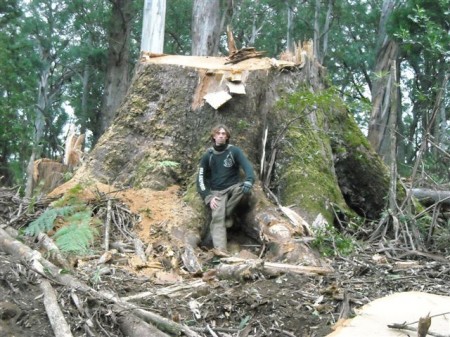 The senseless killing of a 500+ year old rare surviving Eucalyptus regnans
by VicForest contractors in April 2009.
( Photo courtesy of Environment East Gippsland) The senseless killing of a 500+ year old rare surviving Eucalyptus regnans
by VicForest contractors in April 2009.
( Photo courtesy of Environment East Gippsland)
Logging halted at iconic Bungywarr Creek (East Gippsland, Victoria, Australia)
29 April, 2009
‘Today independent forests conservationists are protecting ancient forests from logging in far East Gippsland.
“Two protestors are ‘flying’ a platform located thirty metres up in the tree canopy”, says spokesperson for the group, Ms Lauren Caulfield. “This platform is cabled off to four logging machines, immobilizing them.”
The tree-top protestors are supported by twenty-five forests conservationists on the site.
Bungywarr Creek was first blockaded in 1994, and has remained a contentious logging site ever since.
“Bungywarr Creek forest was identified as iconic almost two decades ago. The old-growth that remains at Bungywarr should be included in the Brumby government’s next round of forest protection”, said Ms Caulfield.
Earlier this month it was revealed that forests like the magnificent stands along Bungywarr Creek are sold to export woodchipping companies for less than the price of a Mars bar – a mere $2.50 per tonne.
“Selling our valuable and carbon-rich native forests for the price of a fast food snack is not making the best financial returns to Victorians”, said Ms Caulfield.
“For VicForests to continue to woodchip the remaining 8% of Victoria’s old-growth forests under Mr Brumby’s watch is a disgrace. Victorians expect and deserve management of our forests for a truly sustainable future.”
“Protecting nature is one of the most important ways to fight climate change”, continued Ms Caulfield. “The forest at Bungywarr Creek will do a better job fighting climate change if it is left intact and able to suck carbon dioxide out of the atmosphere.”
“While the Brumby government dithers on delivering the ageing 2006 old-growth forest promise, logging at Bungywarr Creek is making climate change worse”, concluded Ms Caulfield.”
[Media Release courtesy of Environment East Gippsland]
© The Habitat Advocate Public Domain
|
|
 VicForests’ neo-colonial practice of logging old growth East Gippsland forests, justifies such culling by claiming compliance with Australia’s wood production Standard AS 4708-2007. But this standard is Mein Kampf for ecological genocide of East Gippsland Forests.
VicForests’ neo-colonial practice of logging old growth East Gippsland forests, justifies such culling by claiming compliance with Australia’s wood production Standard AS 4708-2007. But this standard is Mein Kampf for ecological genocide of East Gippsland Forests. VicForests motto reads: “Victorian Timber: beautiful, natural, functional”
VicForests motto reads: “Victorian Timber: beautiful, natural, functional” Vicforests’ coup at Stoney Creek
East Gippsland 2009
Vicforests’ coup at Stoney Creek
East Gippsland 2009
 Woodchip train makes its way to Midways, Geelong (2009) for as little as $2.50 per tonne.
Photo: Wilderness Society Collection
Woodchip train makes its way to Midways, Geelong (2009) for as little as $2.50 per tonne.
Photo: Wilderness Society Collection
 A tombstone of the once impenetrable forest.
A Mountain Ash stump alongside an old forestry track in Balnook, Gippsland.
Note the notches cut in the trunk for standing planks to cut the tree down by axe!
A tombstone of the once impenetrable forest.
A Mountain Ash stump alongside an old forestry track in Balnook, Gippsland.
Note the notches cut in the trunk for standing planks to cut the tree down by axe!

 Scott Gentle from the Victorian Forest Contractors Association
questions the logic of the Yarra Ranges council’s decision to boycott Reflex paper products.
[Source: ^http://free-press-leader.whereilive.com.au/news/story/paper-ban-anger/]
Scott Gentle from the Victorian Forest Contractors Association
questions the logic of the Yarra Ranges council’s decision to boycott Reflex paper products.
[Source: ^http://free-press-leader.whereilive.com.au/news/story/paper-ban-anger/]


























